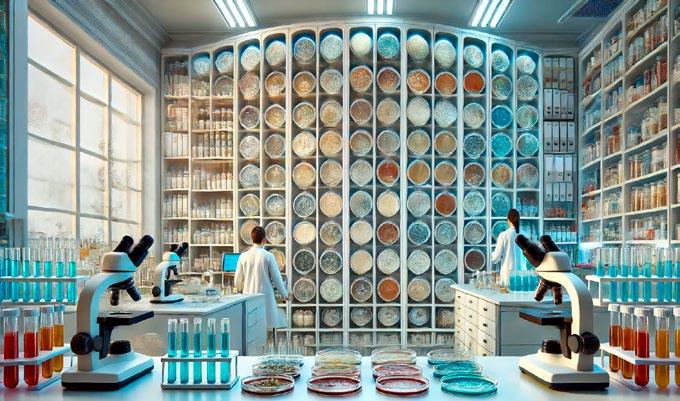Revolutionizing Mycotoxin Control: Innovations in Biocontrol Strategies
Dr. M. Y. Sreenivasa Professor, PhD in Microbiology, University of Mysore (India)


Dr. M.Y. Sreenivasa is a renowned professor in Microbiology from the University of Mysore, India. He has an impressive 20-year career in teaching and research at a postgraduate level. Having published more than 100 research articles in reputed journals with an h-index of 30, his research primarily focuses on the biocontrol of mycotoxins and mycotoxigenic fungi in cereals and cereal-based foods using innovative strategies such as probiotic and PGPR bacteria. He has made significant contributions to our understanding of Fusarium species, the development of rapid detection assays, and the management of mycotoxigenic fungal species.
Dr. Sreenivasa, tell us what inspired you to pursue a career in microbiology and specifically focus on mycotoxins and mycotoxigenic fungi.
Inspired by my teacher, I decided to study microbiology in 10th grade as there are so many probable solutions we can find for today’s problems if we can properly understand microbes.
As they say…
“Small Organisms, but Big Science”
If there were no microorganisms, there definitely would not be any life in this biosphere.
Recently, we have witnessed the impact that microorganisms have in our lives with the COVID-19 crisis.
Regarding mycology and mycotoxicology, it is an area of global concern because fungi are so prevalent worldwide. There is a serious problem of mycotoxigenic fungal contamination, which is known to cause diseases in plants, animals, and humans, as well as produce mycotoxins that pose major risk
So, there is a need for control strategies to target both mycotoxigenic fungi and mycotoxins.
Even though we have many control strategies in cereals, food or feed right from the beginning (before harvest, after harvest, and during processing) mycotoxins are still entering the food chain and causing problems. So, it is crucial to study mycotoxicology and mycotoxins in depth.

What has been your professional journey so far, and how did you end up specializing in the biocontrol of mycotoxins?
When I started my doctoral studies, my PhD topic was the extent of Fusarium and fumonisin contamination in cereals produced in Karnataka, the state where I was residing. I traveled throughout Southern parts of India, collecting and analyzing cereal samples to detect possible contamination with Fusarium and fumonisins.
I discovered that almost all the cereal samples I had collected were highly contaminated with Fusarium and mycotoxins.
That led me to understand that, knowing about the presence of fungi, we need to develop control strategies to fight against them. That is when I started my research focused on control strategies, especially using biological agents.
Your laboratory has reported PCR-based detection methods for mycotoxigenic fungi associated with cereals. Could you elaborate on them?
Initially, when thinking about developing rapid detection methods and going through the existing methods, we saw a need for PCR-based techniques.
I collaborated with a Spanish scientist, María Teresa González who had published many articles on PCR-based methods for the detection of mycotoxigenic fungi.
After exchanging a couple of emails with her, we developed PCR methods for the detection of Fusarium species to identify:
Genus
Species
Toxin-producing abilities
As a result, we developed two important kits, Multiplex PCR and Nested PCR, both have been published in reputed journals.
The developed kits have been standardized and sensitized to detect fungi in pure cultures, seeds, and plant tissues (leaves, stems, and roots).

How effective and sensitive are these PCR-based methods when compared to conventional methods of fungal detection?
In the past, we relied on conventional methods to detect fungi, which are laborious, timeconsuming, and require significant expertise.
However, many reports have highlighted the inaccurate identification of Fusarium species and other fungi. It was later clarified that these were wrongly identified, and now we are able to do it correctly.
In contrast, molecular methods allow us to detect different genes, especially, conserved regions in fungi, such as ITS and IGS.
Another advantage is that we can detect their presence in the early stages, even before they become noticeable in cereals.
Your current research has been focused on mycotoxin biocontrol strategies, particularly using probiotic and PGPR bacteria. Before we delve into this topic, could you explain what PGPR bacteria are and their possible applications in this field of research?
We are parallelly working with probiotic bacteria and PGPR bacteria in our lab.
PGPR is the acronym for “Plant Growth Promoting Rhizobacteria”.
They are beneficial for plants, as they positively influence their growth by:
Solubilizing nutrients
Fixing nitrogen
Producing growth hormones
Protecting against pathogens

Regarding the possible applications of PGPR bacteria, these organisms have been widely used with different applications, such as seed coating, foliar spraying, and direct application to the soil, as they are known to be present in the rhizosphere and phyllosphere.
They compete with pathogens for space and nutrients, and they are known to produce certain antifungal compounds, so they can hinder fungal growth.
Additionally, if by any chance, mycotoxins are produced by the mycotoxigenic fungi, these bacteria can biodegrade them. So, this is an interesting application of PGPR bacteria against pathogens.
Could you elaborate on the research you are doing on probiotic and PGPR bacteria to control Fusarium species in cereal?
Mycotoxins continue to enter the food chain, so we thought about using probiotic bacteria that colonize the digestive system.
If we can characterize efficient probiotic bacteria, we can combat mycotoxins whenever they reach the organism. This is why we chose to work with probiotic bacteria.
Our primary target were Fusarium species. We worked on different species of Fusarium (F. verticillioides, F. proliferatum, F. graminearum, F. culmorum) and other toxigenic fungi, that are significant producers of mycotoxins such as fumonisins and trichothecenes.
If we want to control these organisms and their mycotoxins in the food chain, it is reasonable to use a probiotic organism

At the same time, Fusarium species are also phytopathogens known to cause multiple plant diseases.
If we want to eliminate or fight against them in the plant, it would be beneficial to use a PGPR bacteria
So, in short, if we want to control phytopathogens, it is better to use PGPR bacteria and, if you want to control mycotoxigenic fungi entering the food chain, we can target probiotics. So this is the focus in our laboratory: targeting fungi from all angles, including conidia, mycelium, and mycotoxins.
What are the sources of probiotics you have researched and their possible applications for the control of Fusarium and fumonisins in food and feed?
India is known for its food diversity, with many traditionally fermented foods available.
We started collecting those unexploited traditional fermented foods and worked on isolating possible probiotic organisms.
We have approximately 175 lactic acid bacteria and 123 yeast probiotics that we are maintaining in a probiotic library. So, we screen this library whenever we are interested in targeting different fungi.

Considering the potential applications of these probiotic organisms against fumonisins, our primary focus is using probiotic feed to manage mycotoxigenic fungi and mycotoxins, particularly in poultry feed.
The characterized probiotic bacteria may be used as feed additives or given as live bacteria mixed in the starter feed We are also thinking of encapsulated or lyophilized bacteria in powder form and even exploring oral administration for individual chicks to boost their protection.
How do recent innovative strategies like cold plasma, enzymes, and microbial antagonists integrate with your research on probiotics for controlling fumonisins?
Many scientists are working on controlling strategies and, when it comes to cold plasma, enzymes, and antimicrobial substances, recent developments in probiotics research have led to the concept of postbiotics, the metabolites produced by probiotics.
We can integrate postbiotics with recent novel strategies, combining them with existing enzymes, antimicrobial substances, and probiotics.

What is the current situation regarding mycotoxin prevalence in your region? Have there been any noticeable changes in the patterns of presentation of certain mycotoxins? Are there new mycotoxins or emerging mycotoxigenic fungi that are becoming a concern in your research?
India is an agricultural-based country, mainly dependent on cereals as staple foods which means that there is a major risk of mycotoxin contamination. This problem not only occurs in India but worldwide.
There are many reports published recently in and outside India showing that more than 99% of the screened samples are contaminated. This is possibly due to changes in agricultural practices and climate change. Additionally, developing countries have poor storage facilities that can increase the risk of mycotoxins. >99%
In the past, our attention has primarily centered around aflatoxins when discussing mycotoxins. If you were to ask someone unfamiliar with microbiology or mycology to name a toxin, they would Aflatoxins likely mention aflatoxins.
Now, there is a major concern about Fusarium toxins too. So, in our studies, we have established that there is a high risk of fumonisins and other fusarial toxins such as trichothecenes.
What are some of the biggest challenges you face in your research on mycotoxigenic fungi and their control?
Whenever we think of developing new strategies against mycotoxigenic fungi, the fungal strategy also needs to be taken into consideration.
When screening cereals for fungal contamination, we typically detect numerous fungal species. Despite targeting specific mycotoxins, cereals and grains are likely contaminated with multiple mycotoxins due to the unpredictable response of fungi to environmental conditions.
Sometimes they produce toxins and sometimes they don’t. Sometimes they become very aggressive pathogens and sometimes they don’t. This is a real challenge!
Let me give an example of a challenge we faced.
We screened many PGPR and probiotic bacteria for their ability to degrade mycotoxins using LC/MS and other chromatographic techniques, obtaining positive results. However, when we tried to retest or reconfirm, there was no biodegradation.
To understand what was happening we consulted different research articles and finally got a clue: a small change in pH can alter the total biodegradation! With just a slight change in pH, there was no degradation at all.
Another challenge we are currently working on is to improve the sustainability of the technology we develop because, unlike aflatoxins, which interact with different substrates, such as toxin scavengers and carrier molecules, fumonisins are very poor interactants.
Looking into the future, what do you hope to achieve in the next few years in your research?
Maybe we are too excited for this.
We are interested in isolating a single PGPR or probiotic bacteria capable of controlling multiple mycotoxigenic fungi and multiple mycotoxins. The bacteria we characterize and isolate should be stable under all conditions.
So this is our current focus, and I foresee it yielding positive outcomes for us in the future.
How do you hope your research will impact the agricultural industry and food safety standards globally?
Our research contribution targets the agricultural industry as well as the food industry.
The probiotic bacteria we characterize could be used in the food industry as a toxin binder or feed additive.
Regarding the agricultural industry, if we are able to characterize efficient PGPR bacteria, they can be used in biofertilizers globally.
Can you share any success stories or notable outcomes from your research that have had a significant impact?
One of the successful stories I would like to mention is the PGPR bacteria Azotobacter which we have characterized and is being patented.
We attained an Indian patent for it because it has multiple plant growth promotion functions and it also provides protection for the rice plant
Regarding probiotic bacteria, in our last ten years of research, we have characterized certain isolates that have proven to be very effective in the in vitro studies.
One of these organisms has been studied under in vivo conditions, specifically in poultry challenged with mycotoxins in combination with Lactobacillus plantarum
We got exciting results that are being published in Frontiers in Microbiology. So, we are now exploring the inclusion of Lactobacillus plantarum in feed as an ingredient.
For our readers who are new to the topic, what advice would you give to those interested in pursuing a career in mycotoxin research? Are there any resources or readings you would recommend for further understanding the issues surrounding mycotoxins?
To those budding researchers out there I would say that mycotoxicology and mycotoxins are always interesting. It’s exciting to work with fungi, you’ll love it.
If you are interested in mycotoxicology there is so much material and literature available on microbiology, fungi, and mycotoxins.
I would also say that Mycotoxinsite also provides very useful information, creating awareness about mycotoxigenic fungi and mycotoxins in food and feed, and many other aspects.
Some journals exclusively publish mycotoxin research and mycotoxicological results, like World Mycotoxin Journal and Mycotoxin Research, Journal of Fungi, and Toxicon.
Additionally, there are many books exclusively on mycotoxins and controlling strategies. For example, we have published a book titled Anti-Mycotoxin strategies for Food and Feed, available to those interested in starting a career. To them, a book of this type would be helpful.
I would like to end this interview by saying I’m really excited to showcase my research, my thoughts, and my views on this interesting topic of mycotoxins.
